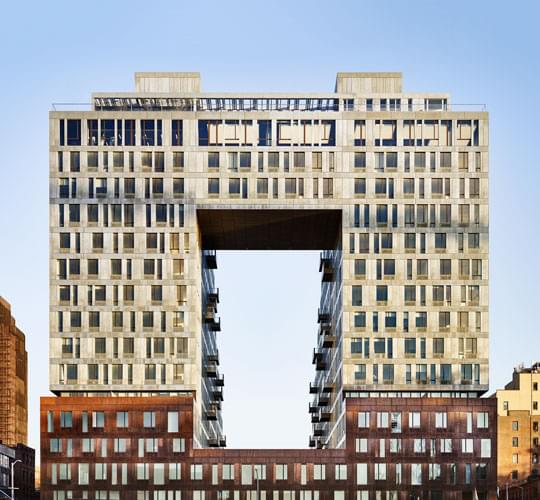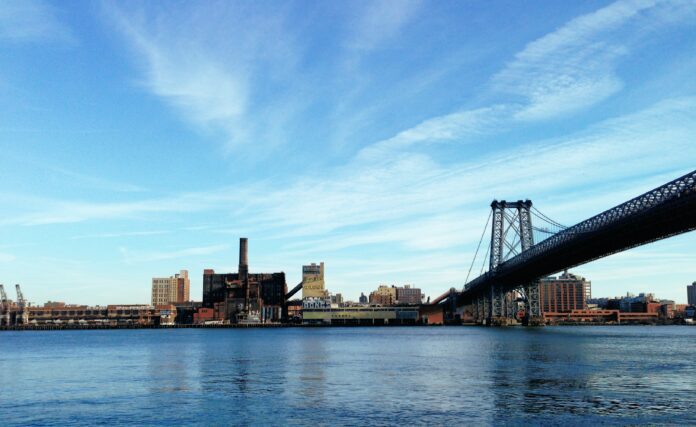New York City is riddled with landmarks that harken back to an industrial past. Many of these landmarks, though abandoned, capture the imagination of city-goers and provide a visual representation of what each neighborhood used to be. The Domino Sugar Factory is one of these landmarks. What was once the largest producer of sugar in the United States is currently an eleven-acre, mixed-use commercial and residential space, with the landmarked refinery still standing strong. The sugar factory is a prime example of how New York City celebrates the old while modernizing the surrounding area.
Opened in 1882 by Theodore A. Havemeyer, the Domino Sugar Factory was the largest refinery in Williamsburg, a neighborhood known for a large number of sugar factories and refineries at the time. Though the Havemeyer family produced around three-quarters of the nation’s sugar before then, a large fire destroyed most of their facilities. However, once the current structure was built, the family was back on top. By 1884, over 5,000 barrels of sugar were being made daily at the refinery. In just a few short years, nearly all of the country’s sugar came from the Havemeyer family and their company, The Sugar Trust.
Domino Sugar as a Sign Of Economic Growth
The Sherman Antitrust Act forced the company to restructure their business, however very little actually changed. The refinery was producing 13,000 barrels of sugar a day in 1894, so the Havemeyers weren’t exactly hurting for cash. In fact, the company was so large that, in 1896, it became one of the first companies sighted in the Dow Jones Industrial Average. That’s right. A sugar company was an indicator for economic growth in the nation. The name “Domino Sugar” came from the grandson of Theodore A. Havemeyer, Henry O. Havemeyer, in the early 1900s.
For a long time, business was great. In 1907, Domino Sugar even built the East River Terminal Railroad to make transportation of their product easier. A fire at the plant in 1917 held things up a bit, especially since they had no insurance because leadership thought the building was immune to fire. However, just a few years later, the plant was employing nearly 5,000 people and shipping over 70,000 tons of sugar per year. However, the 1920s are when Domino Sugar peaked, at least in Brooklyn. The opening of several other large plants, especially in Baltimore, meant Brooklyn plants were reducing the amount of sugar they made.
Employment remained steady through the 1930s and 1940s, though the production of sugar largely hit a plateau. After World War II, the company had to let go of many of its workers, and things only got worse, even after an expansion of the facilities in the 1960s. By the 1970s, Domino Sugar was the only refinery left in Williamsburg. By the mid-’90s only a few hundred people worked at the factory. Domino Sugar closed in 2004, producing only a fraction of the sugar it made in its heyday.
Domino Sugar Factory After its Close
For the next decade, Domino Sugar sat empty and abandoned, left to rot away like the rest of New York’s forgotten industrial buildings. There was even talk of tearing the plant down before historical advocates convinced the Landmarks Preservation Commission to name Domino Sugar a historic landmark in 2007. Seven years later, the city agreed to redevelop the land, keeping the factory intact, while also adding mixed-use commercial and residential buildings. There would also be a new park. Building for this new venture started in 2017, and is largely complete, save for some renovations of the old refinery building.
Domino Sugar Factory Repurposed
There are currently three towers standing in the new Domino Sugar development. The first one built, 325 Kent Avenue, also known as just 325 Kent, is a stunning residential complex with 522 apartments. 105 of those apartments are affordable housing. In fact, both of the new residential buildings have affordable housing in them, a stipulation of building on the land in the first place. One South First on, you guessed it, 1 South 1st Street, has 66 units of affordable housing with 330 units total. The final new structure built was Ten Grand, on 10 Grand Street. This is a retail and office building that connects to One South First via a walkway on the upper floors.

Domino Park
The park is probably the neighborhood’s favorite new addition to the area. It’s a five-acre park that showcases a lot of the old Domino Sugar refinery equipment. There’s even an elevated walkway, with great views of the Manhattan skyline, featuring old cranes and industrial equipment used by the factory, almost like an outdoor museum. It’s not all educational, though. There are plenty of ways to have fun in this park, like playing volleyball or enjoying a taco from the taco stand.
What Will Become of the last Domino Sugar Building?
But what about the last building of the Domino Sugar Factory? What will become of this landmark? The last building remaining is known as the Pan, Filter, and Fishing House. While the exterior is protected by its landmark status, the interior has more wiggle room. In 2020 it was decided that the interior would be transformed into office spaces, and a glass dome would be added to the top of the building. Once this change takes place, all the renovations and construction will be complete, and the building will enter a new age of commerce, business, and industry.
As cool as these renovations are, it is a bit of a shame that landmarks in NYC don’t often have protection for their interiors. I would’ve loved to see a refinery museum showcasing the old equipment, and learn about the history of the building. Sadly, that is not the case, so I must try my best to convey the history of this factory in this article. That said, it’s still amazing that one of the old factory buildings still remains, and that the refinery itself inspired so much innovation to occur on an eleven-acre plot of land. It goes to show that, even when the city can’t stop building new buildings, the old ones will still be around to remind us of our roots.
Russell is a writer and comic based in New York City. His plays have been featured at Penn State’s Cultural Conversation’s Festival, The NYC Thespis Festival, and Imaginarium’s Inaugural Theater Festival. Follow him on TikTok and Instagram @pooleparty528



